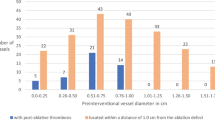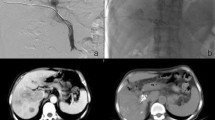Abstract
Purpose
To assess the incidence and sequelae of portal and hepatic venous thrombosis after percutaneous cryoablation of hepatic tumors.
Methods
From November 1998 through December 2010, 223 hepatic tumors were cryoablated during 170 ablation procedures in 135 patients. 24-h post-procedure MR images were reviewed retrospectively by two abdominal radiologists in consensus to identify tumor ablations that developed one or more new portal or hepatic venous thromboses in or outside the ablation zone. On follow-up MRI and CT examinations the outcomes of thromboses were classified as resolved, partially recanalized, persistent, or propagated.
Results
Venous thrombosis developed in association with 54 (24%) of 223 tumor ablations treated during 53 (31%) ablation procedures in 39 (28.8%) patients (15 women, 24 men; age range 40–82 years, mean 59 years). Of these 54 thromboses, 49 (91%) were located in portal vein branches, four (7%) in both portal and hepatic vein branches, and one (2%) in a hepatic vein branch. Thrombosed veins were outside but abutted the ablation zone in 36 (66.7%), and within it in 18 (33.3%). On follow-up imaging (n = 49), thrombi resolved in 29 (59%), partially recanalized in two (4%), persisted in 18 (37%) and propagated from sub-segmental or segmental branches to the left or right portal branches in five (10%). No thrombus propagated to the main portal vein or inferior vena cava.
Conclusion
Portal and hepatic vein branch thromboses are common in small branches following percutaneous cryoablation of hepatic tumors and most resolve spontaneously without sequelae.




Similar content being viewed by others
References
Gervais DA, Goldberg SN, Brown DB, et al. (2009) Society of interventional radiology position statement on percutaneous radiofrequency ablation for the treatment of liver tumors. J Vasc Interv Radiol 20:S342–S347
Bang HJ, Littrup PJ, Currier BP, et al. (2012) Percutaneous cryoablation of metastatic lesions from non-small-cell lung carcinoma: initial survival, local control, and cost observations. J Vasc Interv Radiol 23:761–769
Tatli S, Acar M, Tuncali K, et al. (2010) Percutaneous cryoablation techniques and clinical applications. Diagn Interv Radiol (Ank Turk) 16:90–95
Cha C, Lee FT Jr, Rikkers LF, et al. (2001) Rationale for the combination of cryoablation with surgical resection of hepatic tumors. J Gastrointest Surg 5:206–213
Conners D, Rilling W (2011) Pleural tumor seeding following percutaneous cryoablation of hepatocellular carcinoma. Semin Intervent Radiol 28:258–260
Jungraithmayr W, Burger D, Olschewski M, Eggstein S (2005) Cryoablation of malignant liver tumors: results of a single center study. Hepatobiliary Pancreat Dis Int HBPD INT 4:554–560
Poon RT, Fan ST, Tsang FH, Wong J (2002) Locoregional therapies for hepatocellular carcinoma: a critical review from the surgeon’s perspective. Ann Surg 235:466–486
Xu KC, Niu LZ, He WB, et al. (2003) Percutaneous cryoablation in combination with ethanol injection for unresectable hepatocellular carcinoma. World J Gastroenterol WJG 9:2686–2689
Shock SA, Laeseke PF, Sampson LA, et al. (2005) Hepatic hemorrhage caused by percutaneous tumor ablation: radiofrequency ablation versus cryoablation in a porcine model. Radiology 236:125–131
Pasricha PJ, Hill S, Wadwa KS, et al. (1999) Endoscopic cryotherapy: experimental results and first clinical use. Gastrointest Endosc 49:627–631
Kopelman D, Klein Y, Zaretsky A, et al. (2000) Cryohemostasis of uncontrolled hemorrhage from liver injury. Cryobiology 40:210–217
Ahmed M, Solbiati L, Brace CL, et al. (2014) Image-guided tumor ablation: standardization of terminology and reporting criteria: a 10-year update. J Vasc Interv Radiol JVIR 25:1691–705.e4
Nair RT, Silverman SG, Tuncali K, Obuchowski NA, et al. (2008) Biochemical and hematologic alterations following percutaneous cryoablation of liver tumors: experience in 48 procedures. Radiology 248:303–311
de Baere T, Risse O, Kuoch V, et al. (2003) Adverse events during radiofrequency treatment of 582 hepatic tumors. AJR Am J Roentgenol 181:695–700
Kim AY, Rhim H, Park M, et al. (2011) Venous thrombosis after radiofrequency ablation for hepatocellular carcinoma. AJR Am J Roentgenol 197:1474–1480
Lin J, Zhou KR, Chen ZW, et al. (2003) Three-dimensional contrast-enhanced MR angiography in diagnosis of portal vein involvement by hepatic tumors. World J Gastroenterol WJG 9:1114–1118
Hoffmann NE, Bischof JC (2002) The cryobiology of cryosurgical injury. Urology 60:40–49
Zhang A, Xu LX, Sandison GA, Cheng S (2006) Morphological study of endothelial cells during freezing. Phys Med Biol 51:6047–6060
Baust JG, Gage AA (2005) The molecular basis of cryosurgery. BJU Int 95:1187–1191
Littrup PJ, Jallad B, Vorugu V, et al. (2009) Lethal isotherms of cryoablation in a phantom study: effects of heat load, probe size, and number. J Vasc Intervent Radiol JVIR 20:1343–1351
Silverman SG, Tuncali K, Morrison PR (2005) MR imaging-guided percutaneous tumor ablation. Acad Radiol 12:1100–1109
Lu DS, Raman SS, Vodopich DJ, et al. (2002) Effect of vessel size on creation of hepatic radiofrequency lesions in pigs: assessment of the “heat sink” effect. AJR Am J Roentgenol 178:47–51
Eggstein S, Neeff H, Szarzynski M, et al. (2003) Hepatic cryotherapy involving the vena cava: experimental study in a pig liver model. Eur Surg Res 35:67–74
Onik G, Rubinsky B, Zemel R, et al. (1991) Ultrasound-guided hepatic cryosurgery in the treatment of metastatic colon carcinoma: preliminary results. Cancer 67:901–907
Conflict of interest
All authors declare that he/she has no conflict of interest.
Ethical approval
All procedures performed in studies involving human participants were in accordance with the ethical standards of the institutional and/or national research committee and with the 1964 Helsinki declaration and its later amendments or comparable ethical standards.
Informed consent
Informed consent from all individual participants was waived for this retrospective study approved by our Institutional Review Board.
Author information
Authors and Affiliations
Corresponding author
Rights and permissions
About this article
Cite this article
Sainani, N.I., Silverman, S.G., Tuna, I.S. et al. Incidence and clinical sequelae of portal and hepatic venous thrombosis following percutaneous cryoablation of liver tumors. Abdom Radiol 41, 970–977 (2016). https://doi.org/10.1007/s00261-015-0626-2
Published:
Issue Date:
DOI: https://doi.org/10.1007/s00261-015-0626-2




